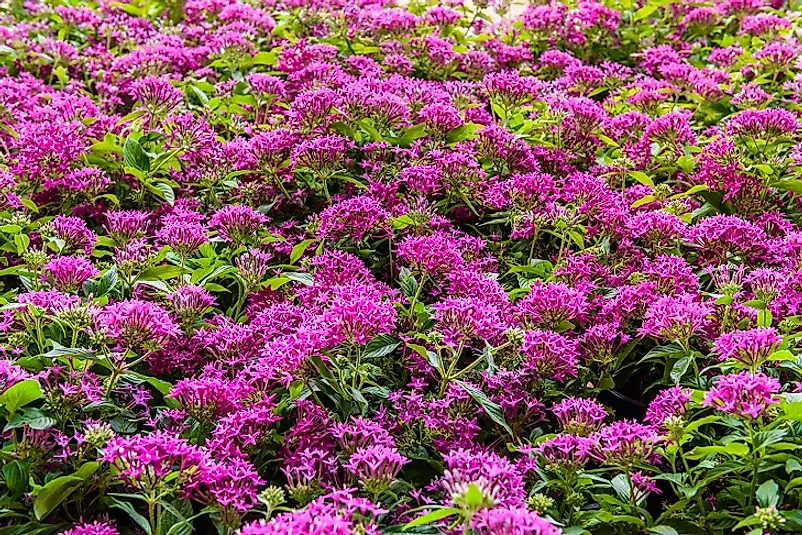Native Plants Of The Democratic Republic Of The Congo (Congo-Kinshasa)

The Democratic Republic of the Congo (DRC) is a landlocked central African country known for its rich biodiversity of wildlife. The plants of the Democratic Republic of the Congo are distributed within the five ecological regions of the country, among them tropical and sub-tropical grasslands, tropical and subtropical moist broad-leaf forests, flooded grasslands and savannas, and mangroves. Though the most of the regions remain highly unaltered, expanding human population and activities pose a threat to the diversity of this country.
Glabra (Anubias barteri var. glabra)
The Glabra is an aquatic and semi-aquatic angiosperm plant native to parts of West Africa, including the Democratic Republic of the Congo. The plant has narrow spear-shaped leaves, a leaf stem of around 35 centimeters and can survive amid low light intensity. The plant is used as an aquarium plant due to its reduced requirements and low predation by herbivorous fishes. The plant is found in the rainforest streams and swamps of the Democratic Republic of the Congo growing on the river banks and rocks in the stream. They have a very slow growth rate with about four leaves a year. The species has been classified as least concern due to the ability to propagate it in aquariums.
Egyptian Starcluster (Pentas lanceolata)
The Egyptian Starcluster is a tropical woody sub-shrub perennial and herbaceous plant native to eastern and central Africa, as well as to Yemen in the Arabian Peninsula. The grows to heights of 3 to 6 inches in its natural habitats. It has evergreen leaves and star-shaped white, pink, lilac, or magenta showy flowers that occur in rounded clusters. The plant can tolerate partial shade but does well in full exposure to the sun.
Gabon Ebony (Diospyros crassiflora)
The Gabon ebony is an endangered species of lowland forest tree endemic to the Democratic Republic of the Congo. The tree grows to about 50 to 60 feet tall with a trunk diameter of 2 to 3 feet. The tree is said to produce the blackest heartwood which is hard, durable, has fine pores and polishes well thus making it a highly over-exploited species. The tree is found in the Central African Republic, Cameroon, Gabon, Nigeria, and Congo.
Emin’s Strophanthus (Strophanthus eminii)
Emin’s Strophanthus is native to the Democratic Republic of Congo, with its habitats being found in the deciduous woodlands and rocky bushlands lying at elevations of between 600 meters and 1,650 meters. The plant may grow as a liana reaching a length of 10 meters, or as a shrub or small tree of around 7 meters in height. The diameter of the tree stem can reach 6 centimeters, and the plant produces fragrant flowers with a pink, white, or red corolla tube. The plant is exploited for local medicinal treatments such as treating snakebites, skin diseases and wounds.
Sjambok Pod (Cassia abbreviata)
The sjambok pod is a deciduous tree with long, tail-like, dehiscent, seed pods, and it grows to a height of 6 to 12 meters. The sjambok has its habitats in open woodlands, along with water courses, slopes, and near termite mounds. The tree has a rough brown-gray bark on the stem, a rounded crown, and paripinnate compound leaves. Dark yellow flowers are produced at the end of the branches and last for about a month. The tree is native to the Democratic Republic of the Congo, as well as other African countries including Botswana, Kenya, Namibia, and Tanzania. It is mainly found in tropical areas.
Conservation Efforts to Protect Congolese Flora
Other native plants in the Democratic Republic of the Congo include Lubbers’ Oeceoclades Orchid, the African Jessenia Liverwort, the Black Guarea, the Wooden Pear, and the Haut-Katanga Dayflower. Threats to the flora of the Democratic Republic of the Congo include pressure on forests due to population increase, construction of roads, logging and oil palm plantations which lead to the destruction of the natural ecosystems thus threatening the survival of these plant species. Conservation measures include educating the population and working together with them to safeguard the natural biodiversity. These actions are typically initiated by nongovernmental organizations (NGOs).
Native Plants Of The Democratic Republic Of The Congo (Congo-Kinshasa)
| Native Plants of the Democratic Republic of the Congo | Scientific Name |
|---|---|
| Glabra | Anubias barteri var. glabra |
| Egyptian Starcluster | Pentas lanceolata |
| Gabon Ebony | Diospyros crassiflora |
| Emin's Strophanthus | Strophanthus eminii |
| Sjambok Pod | Cassia abbreviata |
| Lubbers' Oeceoclades Orchid | Oeceoclades lubbersiana |
| African Jensenia Liverwort | Jensenia spinosa |
| Black Guarea | Guarea thompsonii |
| Wooden Pear | Schrebera trichoclada |
| Haut-Katanga Dayflower | Commelina orchidophylla |











